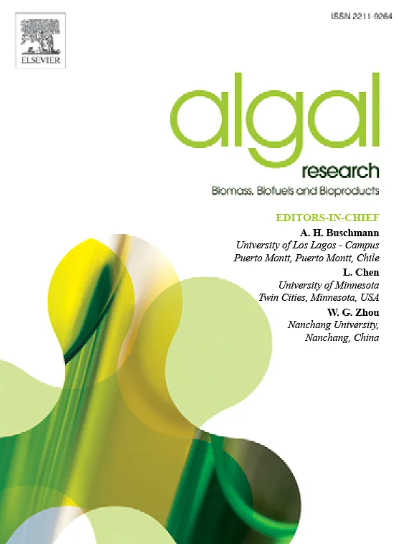高倍率藻塘串联运行处理生活污水的效果:水动力学、修复潜力和生物质生产
IF 4.5
2区 生物学
Q1 BIOTECHNOLOGY & APPLIED MICROBIOLOGY
Algal Research-Biomass Biofuels and Bioproducts
Pub Date : 2025-05-10
DOI:10.1016/j.algal.2025.104091
引用次数: 0
摘要
操作修改是一种有前途的、具有成本效益的策略,可以提高藻类系统在污水处理中的效率。在此背景下,本研究探讨了高速率藻塘(hrap)串联运行对生活污水处理的有效性,重点是通过评估污染物去除效率和生物质产量来提高技术性能。水动力分析确定hrap的Bodenstein值为9.7,表明混合状态完全,并提示串联操作的潜在好处。随后,操作了两个系统,每个系统包括两个HRAP:一个串联操作(每个HRAP的水力停留时间(HRT)为5天),一个并联操作(每个HRAP的HRT为10天)。串联操作的大肠菌群和大肠杆菌去除率(97.79%和98.33%)高于并联操作的84.09%和89.56%,而在养分去除率和生物质产量方面无统计学差异。然而,平行系统的TOC去除率高14%,生物量更高,脂质(19%)、蛋白质(76%)和碳水化合物(44%)含量更高,而串联系统的灰分含量更高(65%)。讨论了流体动力学、营养平衡和衰老的作用,以解释每个系统的性能。除了对两个以上的池进行串联测试外,未来的研究应侧重于通过优化混合来达到塞流状态。本文章由计算机程序翻译,如有差异,请以英文原文为准。

Effects of series operation of high-rate algal ponds treating sanitary sewage: hydrodynamics, remediation potential, and biomass production
Operational modifications are a promising, cost-effective strategy to increase the efficiency of algal systems applied to sewage treatment. In this context, this study investigates the effectiveness of operating High-rate Algal Ponds (HRAPs) in series for sanitary sewage treatment, focusing on improving technical performance by assessing pollutant removal efficiencies and biomass production. A hydrodynamic analysis determined Bodenstein's value of 9.7 for HRAPs, indicating a complete mixing regime and suggesting potential benefits to series operation. Subsequently, two systems were operated, each comprising two HRAPs: one operated in series (with a hydraulic retention time (HRT) of 5 days in each HRAP) and one operated in parallel (with an HRT of 10 days in each HRAP). The series operation achieved higher coliforms and E. coli removal (97.79 % and 98.33 % compared to 84.09 % and 89.56 % in parallel), while no statistically significant differences were observed in nutrient removal or biomass production. However, the parallel system exhibited 14 % higher TOC removal and biomass with greater lipid (19 %), protein (76 %), and carbohydrate (44 %) content, while the series had higher ash content (65 % higher). Discussions approach the roles of hydrodynamics, nutrient balance, and senescence to explain the performance of each system. Future research should focus on reaching a plug flow regime by optimizing mixing, besides testing more than two ponds in series.
求助全文
通过发布文献求助,成功后即可免费获取论文全文。
去求助
来源期刊

Algal Research-Biomass Biofuels and Bioproducts
BIOTECHNOLOGY & APPLIED MICROBIOLOGY-
CiteScore
9.40
自引率
7.80%
发文量
332
期刊介绍:
Algal Research is an international phycology journal covering all areas of emerging technologies in algae biology, biomass production, cultivation, harvesting, extraction, bioproducts, biorefinery, engineering, and econometrics. Algae is defined to include cyanobacteria, microalgae, and protists and symbionts of interest in biotechnology. The journal publishes original research and reviews for the following scope: algal biology, including but not exclusive to: phylogeny, biodiversity, molecular traits, metabolic regulation, and genetic engineering, algal cultivation, e.g. phototrophic systems, heterotrophic systems, and mixotrophic systems, algal harvesting and extraction systems, biotechnology to convert algal biomass and components into biofuels and bioproducts, e.g., nutraceuticals, pharmaceuticals, animal feed, plastics, etc. algal products and their economic assessment
 求助内容:
求助内容: 应助结果提醒方式:
应助结果提醒方式:


